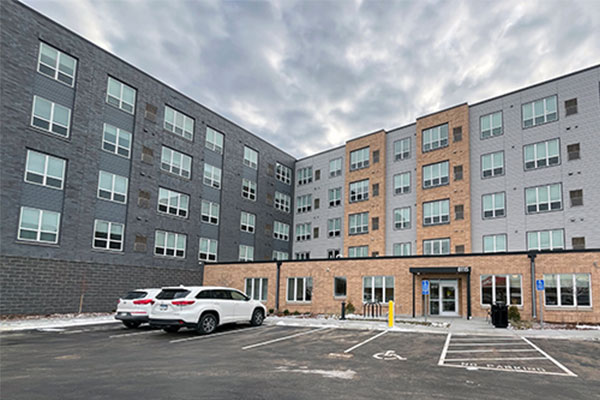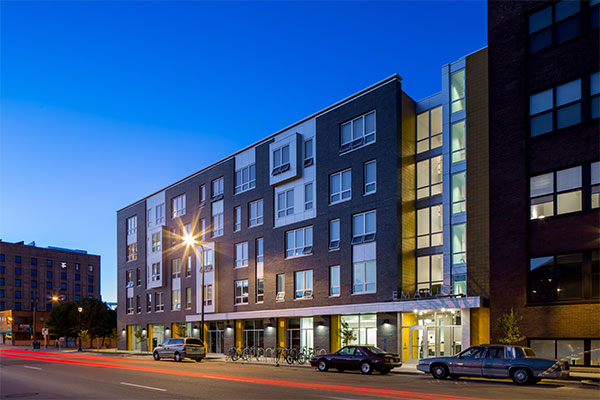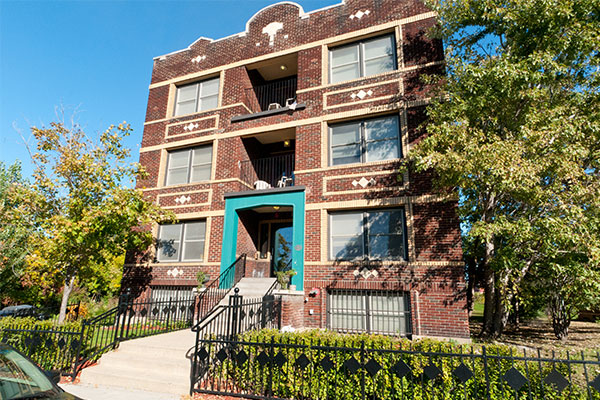All about AHIF: the little funding engine that could

The Lamereaux in Minneapolis, funded by AHIF and developed by Aeon, offers apartment homes and stability to individuals who have experienced homelessness (photo courtesy of Aeon).
The county has been running the Affordable Housing Incentive Fund (AHIF) for over 20 years. It doesn’t often make headlines, but it is making an outsized impact on communities.
The program’s aim is to support the development of affordable housing units for very low-income households. And since 2000, AHIF has funded over 10,000 units of affordable housing through 202 projects, with an average of 421 units created per year and an average of $3.2 million distributed per year. AHIF often acts as a “last gap” financer of projects that need a boost to get fully funded.
“AHIF has been like the little train that could and keeps chugging along,” says Julia Welle Ayres, the county’s director of housing development and finance. “And by stepping up and committing final gap funding, we can leverage even more funding from partners to see projects through, which makes a big impact on what’s possible.”
In fact, since 2000 the county's aid through AHIF has also allowed it to leverage another $1.9 billion from other sources to complete affordable housing projects.

Filling a gap in affordable housing
When the county began the program over two decades ago, there was a shortage of affordable housing for very low-income households. The creation of AHIF was an intentional step toward closing that gap in both urban and suburban areas. According to a 2023 analysis, most residents in AHIF buildings earn an income, but incomes are extremely low, averaging around $13k per year.
“With AHIF, we’re working hard to combat the shortage of decent, safe, housing that people making lower incomes can actually afford,” says Abbie Loosen, Multi-Family Housing Development Manager. “We focus on development that creates housing opportunities for people paying more than 30% of their income toward rent and other housing costs (this is what is known as being housing cost burdened) and we know that cost-burdened households live in almost every city in Hennepin County.”
Many of the projects built—from Rogers to Edina to Minneapolis—also include units set aside for people experiencing long-term homelessness. And while most of the projects are in core cities, the county is always looking to fund more developments in the suburbs.
"The fund gives the county a specific voice on what affordable housing will look like," said Welle Ayres. "When the county funds a project, we look at affordability, but we also consider location—proximity to transit and jobs, livability, and community.”
The funding works through financial assistance to municipalities, other government and nonprofit agencies, private and nonprofit housing developers and lenders to support the creation or preservation of long-term affordable housing across the county, typically in the form of a deferred low-interest loan. It operates under the purview of the Hennepin County Housing and Redevelopment Authority.
Developments that make a difference

The exterior of Rise on 7, an affordable housing development funded by AHIF in St. Louis Park (photo courtesy of Lloyd Management).
Rise on 7
Rise on 7, on the border of Hopkins and St. Louis Park, was developed by CommonBond and opened in 2023. Close to amenities and services for residents—and located in the suburbs, an increasingly requested area for affordable housing—Rise on 7 is an excellent example of how county AHIF funding can bring others to the table.
The county committed $950,000 in AHIF capital funds in addition to $700,000 in pandemic recovery funding. Because of the county’s early and significant investment, we were able to also administer $950,000 of pass-through funding from the Metropolitan Council LHIA funds. These commitments helped to get the remainder of funding on board to close the project.
Rise on 7 provides 120 units of much-needed affordable rental housing. Over half the units are affordable to lower-income households who make less than 50% AMI. An impressive 18 of those units are affordable for households at the 30% AMI level. Six of those units are dedicated to people exiting homeless and have access to on-site supportive services. Plus, daycare is provided on site, a huge benefit for working families.

Emanuel Housing in Minneapolis was funded by AHIF and has 101 units: six one-bedroom apartments and the remainder studios (photo by Farm Kid Studios, courtesy of RS Eden).
Emanuel Housing
Emanuel Housing in Minneapolis was developed by RS Eden and built in 2012. AHIF provided $650,000 to help make this development a reality. It has 101 units, mostly studios, in addition to six one-bedroom apartments. There are 16 units available at the 30% AMI level, with the remainder at 50% AMI.
Emanuel offers recovery-focused, supportive, and permanent housing. Located close to the light rail, bus routines, hospitals, schools, and near human service agencies, the apartment offers a suite of amenities to support low-income residents to maintain housing stability. It stands as an example of the supportive housing projects AHIF has funded over the years, providing services and operating models tailored to meet human services needs.

The Coyle is an AHIF-funded development in Minneapolis that is home to 26 people (photo courtesy of Aeon).
Aeon Portfolio Preservation
In 2016, Aeon rehabbed older buildings in downtown Minneapolis, and combined them into one portfolio that now provides 116 units total, including 59 units at 30% AMI and 57 units at 50% AMI. Most of these units provide supportive housing for people exiting homelessness.
- The Continental offers stable apartment homes for 70 formerly homeless people. Supportive services are provided through an on-site case manager and supportive services team.
- The Lamereaux offers apartment homes and stability to individuals who have experienced homelessness. Like the Continental, on-site supportive services are available. The development was first renovated by Aeon in the early 1990s, with an addition completed in 2003.
- The Coyle is home to 26 people who have experienced homelessness. Residents live independently, and Aeon provides Resident Connections services to provide stability and help create a home.
These three developments are part of the housing support continuum designed specifically for single adults exiting homelessness. They’re a part of AHIF’s decades-long work to end homelessness.
Addressing disparities in housing affordability
The deepest disparities in housing exist at the lowest income levels. This correlates to the significant racial disparities in households that spend more than 30% of their income on housing. For example, 51% of black households are housing cost burdened, while 25% of white households are housing cost burdened.

Hennepin County is directly addressing the unequal cost-burden that impacts households of color and puts them at risk of losing their housing. We do this by focusing AHIF on low-income households and participating in a broader community of practice that has worked together to reduce access barriers existing in non-subsidized housing. As a result, 74% of residents who live in AHIF-funded buildings are Black, but only 14% of the population in Hennepin County identifies at Black.
“Housing is fundamental to making other strides in life, such as advancing education and career goals,” says Loosen, “so reducing housing disparities is fundamental to closing the gap on other disparities. When households have stable housing, it’s possible for them to envision next steps to build on.”
AHIF: the next 20 years and beyond
Recently, through a partnership between Hennepin County and the University of Minnesota, a graduate-level intern completed a comprehensive evaluation report of AHIF’s impact and perceptions among developers and residents. Among many things, the report found that although there is a high need for AHIF properties in urban areas, there is a growing desire for more affordable housing in suburban areas as well.
Through data provided by HousingLink, we learned that amongst those searching for affordable housing between 2018-2022, Minneapolis was the most sought-after city in Hennepin County followed by Plymouth and Bloomington. In focus groups held with residents of AHIF-funded buildings, residents told us that they were looking for housing with amenities that met their specific needs, such as an on-site computer lab, surface parking, supportive services, and increased safety.
As the county’s AHIF funding passes the 23-year mark, these insights and more will inform next steps and the program’s impact moving forward.
“AHIF will continue to be an important thread through our capital housing funding programs,” says Loosen. “With some of the learnings from the evaluation process, we will strengthen and improve upon what’s already working well. We’re looking forward to AHIF quietly—but effectively—continuing its great work for the next 20 years.”